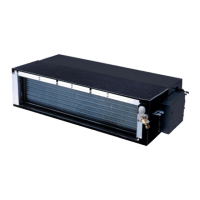15 EN
ENGLISHFRANÇAISDEUTSCHITALIANOESPAÑOLPORTUGUÊSΕΛΛΗΝΙΚΑ
Use a vacuum pump
Be sure to use a vacuum pump with counter-flow prevention function so that inside oil of the pump does not flow backward into pipes
of the air conditioner when the pump stops.
1. Connect the charge hose from the manifold valve to the service port of the gas side packed valve.
2. Connect the charge hose to the port of vacuum pump.
3. Open fully the low pressure side handle of the gauge manifold valve.
4. Operate the vacuum pump to start for evacuating.
Perform evacuating for about 35 minutes if the piping length is total 70 meters.
(25 minutes for total 50 meters)
(assuming a pump capacity of 27 liters per minute.)
Then confirm that the compound pressure gauge reading is –101 kPa (–76 cmHg).
5. Close the low pressure side valve handle of gauge manifold.
6. Open fully the valve stem of the packed valves (both sides of Gas and Liquid).
7. Remove the charging hose from the service port.
8. Securely tighten the caps on the packed valves.
Packed valve handling precautions
• Open the valve stem all the way out; do not try to open it beyond the stopper.
• Securely tighten the valve stem cap in torque as follows:
8EVACUATING
EVACUATION
Evacuate the air in the connecting pipes and in the indoor unit using vacuum pump.
Do not use the refrigerant in the outdoor unit. For details, see the manual of vacuum pump.
Gas side (12.7 mm (diam.)) 50 to 62 N·m (5.0 to 6.2 kgf·m)
Gas side (9.52 mm (diam.)) 33 to 42 N·m (3.3 to 4.2 kgf·m)
Liquid side (6.35 mm (diam.)) 14 to 18 N·m (1.4 to 1.8 kgf·m)
Service port 14 to 18 N·m (1.4 to 1.8 kgf·m)
Hexagon wrench
is required.
Pressure gauge
Manifold valve
Handle Hi (Keep full closed)
Charge hose
Vacuum pump adapter for
counter-flow prevention
Service port
(Valve core (setting pin))
Vacuum
pump
Packed valve at gas side
Packed valve at liquid side
Charge hose
Handle Lo
–101 kPa
(–76 cmHg)
Compound
pressure gauge

